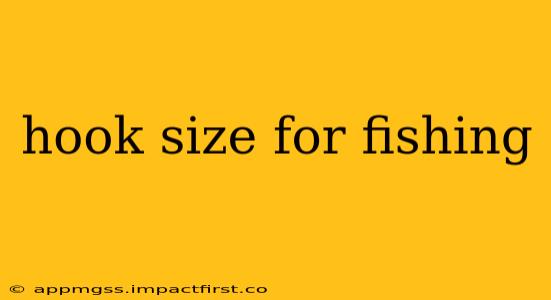Choosing the right hook size for fishing is crucial for success. The wrong size can mean the difference between a successful catch and a frustrating day on the water. This comprehensive guide will help you understand hook sizes, how to choose the appropriate size for different species and fishing techniques, and answer some frequently asked questions.
Understanding Hook Size Terminology
Hook sizes are generally represented by a number, with smaller numbers indicating larger hooks. This might seem counterintuitive at first, but it's a standard convention across most hook manufacturers. For example, a size 1 hook is significantly larger than a size 10 hook. The exact dimensions vary slightly depending on the hook style and manufacturer, but the general principle remains the same.
What Factors Determine the Right Hook Size?
Several factors influence the ideal hook size for your fishing trip:
-
Target Species: Larger fish require larger hooks to securely hold them, while smaller fish need smaller hooks to avoid injury and maximize hook-up rates. A bass will need a considerably larger hook than a bluegill.
-
Bait or Lure Size: The hook size should be proportionate to the bait or lure you're using. A small hook with a large minnow will result in a poor presentation and likely won't be effective.
-
Fishing Technique: Different fishing techniques call for different hook styles and sizes. For example, finesse fishing might employ smaller hooks, while targeting larger predatory fish with larger lures might necessitate larger hooks.
-
Water Conditions: In murky water, larger hooks with brighter colors might improve visibility, whereas clear water might benefit from smaller, less intrusive hooks.
How to Choose the Right Hook Size for Different Fish
Here's a general guideline; however, always consult species-specific fishing guides for more precise information:
| Fish Species | Hook Size Range | Notes |
|---|---|---|
| Trout | #6 - #12 | Varies greatly depending on size and technique |
| Bass | #1/0 - #4/0 | Larger sizes for bigger bass |
| Panfish (Bluegill, Sunfish) | #6 - #10 | Smaller hooks for delicate mouths |
| Catfish | #1/0 - #8/0 or larger | Size varies widely depending on size |
| Salmon | #2 - #6 | Depending on size and method |
Frequently Asked Questions
What is the smallest hook size?
The smallest hook sizes are usually in the #10 to #16 range, and even smaller specialized hooks exist. These are ideal for catching small panfish or using with tiny bait.
What is the largest hook size?
There's no definitive "largest" hook size, as manufacturers produce hooks of various sizes for specialized applications. Extra large hooks, designated with numbers like 10/0 or even larger, are used for extremely large game fish like marlin or sharks.
Can I use a larger hook than recommended?
While tempting to use larger hooks to improve your chances of landing a fish, it can significantly decrease your hook-up rate. Too large a hook can be easily avoided by fish, especially more cautious and finicky ones. Using a hook that’s too large is also inhumane, causing potential unnecessary injury to the fish.
Can I use a smaller hook than recommended?
Using a smaller hook than recommended can lead to more missed fish, as the hook might not penetrate deeply enough or could bend under the pressure of a larger fish. The hook might pull out, resulting in a lost fish.
Where can I find a hook size chart?
Many fishing tackle websites and resources offer hook size charts, showing the dimensions of different hook sizes for various manufacturers. These charts are helpful for comparing hooks from different brands.
Choosing the right hook size is a crucial aspect of successful fishing. Understanding the factors involved and consulting resources specific to your target species and fishing technique will significantly improve your chances of a rewarding fishing experience. Remember to always practice responsible angling techniques and respect the environment.
